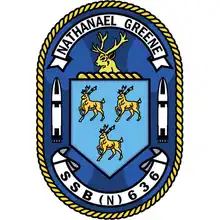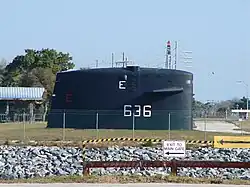.jpg.webp) USS Nathanael Greene (SSBN-636), probably during her sea trials off New England in the mid-1960s. | |
| History | |
|---|---|
| Namesake | Nathanael Greene (1746-1782), a major general in the Continental Army during the American Revolutionary War |
| Ordered | 21 July 1961 |
| Builder | Portsmouth Naval Shipyard, Kittery, Maine |
| Laid down | 21 May 1962 |
| Launched | 12 May 1964 |
| Sponsored by | Mrs. Neander W. Wade |
| Commissioned | 19 December 1964 |
| Decommissioned | 15 December 1986 |
| Stricken | 31 January 1987 |
| Fate | Scrapped via Ship-Submarine Recycling Program began 1 September 1998 and completed 20 October 2000 |
| Badge |  USS-Nathanael-Greene-SSBN-636 |
| General characteristics | |
| Class and type | James Madison-class submarine |
| Displacement |
|
| Length | 425 ft (130 m) |
| Beam | 33 ft (10 m) |
| Draft | 31 ft 5 in (9.58 m) |
| Installed power | S5W reactor |
| Propulsion | 2 × geared steam turbines, one shaft 15,000 shp (11,185 kW) |
| Speed |
|
| Test depth | 1,300 ft (400 m) |
| Complement | Two crews (Blue and Gold) of 13 officers and 130 men each |
| Armament |
|
USS Nathanael Greene (SSBN-636), a James Madison-class fleet ballistic missile submarine, was the third ship of the United States Navy to be named for Major General Nathanael Greene (1746–1786), who served in the Continental Army during the American Revolutionary War.a
Construction and commissioning
Nathanael Greene's keel was laid down on 21 May 1962 at the Portsmouth Naval Shipyard in Kittery, Maine. The construction of the ship was supervised by Commander Lawrence Dennis Ballou. She was launched on 12 May 1964, sponsored by Mrs. Neander W. Wade, a descendant of Nathanael Greene, and commissioned on 19 December 1964 with Commander Robert E. Crispin in command of the Blue Crew and Commander William M. Cossaboom in command of the Gold Crew.
Service history
Nathanael Greene departed Portsmouth for shakedown on 30 December 1964, with her Gold Crew embarked; it was relieved on 1 February 1965 by the Blue Crew. Her shakedown period was followed by repairs and alterations at Portsmouth Naval Shipyard, after which the submarine, with her Blue Crew embarked, departed the shipyard for ballistic missile loading and her initial Polaris missile deterrent patrol.
In 1970-1971 Nathanael Greene was refueled and received its conversion to launch Poseidon missiles at Newport News Shipbuilding. Following Yard period and Shakedown, the Greene proceeded to Cape Canaveral for a test missile launch. In March 1972 the Greene departed for her first deterrent patrol following conversion ending up in Holy Loch, Scotland.
- History needed for 1965-1986.
Events and deactivation
On January 29, 1970, while making a surface run into port in thick fog, Nathanael Greene ran aground in about 16 feet of water. She was refloated after about 7 hours.[1]
On August 11, 1984, Nathanael Greene lost her propeller in the Irish Sea. While proceeding back to Holy Loch at about 3 knots using her secondary propulsion motor, a transit of about 5 or 6 days, she was redirected to Her Majesty's Naval Base, Clyde at Faslane as the U.S. dry dock in Holy Loch was fully committed and unavailable, while Admiralty Floating Dock No. 60 at Faslane was available. While in the Faslane dry dock, a fire occurred in one of the dock's enclosed machinery spaces on 18 August 1984. The fire was quickly extinguished and did not affect the Greene. While in dry dock, it was established that the main shaft had broken with the loss of about a third of its length along with the propeller. Repairs were completed in about 12 days with the Nathanael Green undocked on 3 September 1984.[2]
On 13 March 1986 Nathanael Greene ran aground in the Irish Sea, suffering severe damage to her rudder and ballast tanks. Her grounding was a serious accident involving a U.S. Navy nuclear-powered ballistic missile submarine. She was deactivated while still in commission in May 1987. Her early deactivation was decided both as a result of the damage sustained in the accident as well as in accordance with the limitations set by the SALT II treaty.
Decommissioning and disposal

Nathanael Greene was decommissioned on 15 December 1986 and stricken from the Naval Vessel Register on 31 January 1987. Her removal from service allowed the United States to comply easily with the ballistic missile limits of the SALT II strategic arms limitation treaty.
Nathanael Greene entered the U.S. Navy's Nuclear-Powered Ship and Submarine Recycling Program at Bremerton, Washington, on 1 September 1998. Her scrapping was completed on 20 October 2000.
Commemoration

Nathanael Greene's sail has been restored and is now on display in Port Canaveral, Florida as a memorial to the original 41 for Freedom fleet ballistic missile submarines.
Notes
^a The other two ships are named USS General Greene.
References
- ↑ "Smooth Log, North Atlantic Weather - January and February 1970". Mariners Weather Log. United States Department of Commerce. 14 (4): 214. July 1970. Retrieved 10 November 2022.
The 425-ft Polaris submarine NATHANAEL GREENE, negotiating the Charleston Harbor's narrow entrance channel in a dense fog on the 29th, strayed 300 ft outside the channel and ran aground in about 16 feet of water. The sub was stuck in mud for 7 hr before it was released by four tugs. Divers inspected the hull and found no damage.
- ↑ Fall, Peter. "Docking Nathanael Greene (SSBN-636) in AFD 60". NavSource Online: Submarine Photo Archive. NavSource History. Retrieved 10 November 2022.
Selected text: In mid-August the Dockmaster was out of area on leave and I was asked if we could dock an American SSBN in AFD 60... AFD 60's next planned docking was over 2 weeks away, so provisionally, yes we could...What the U.S. personnel found so amazing was that the docking had been completed so quickly ~ from arriving at the dock entrance at about 0800 we were up and dry by 1230... Everything but everything needed for the boat's time in dock was flown in from the States; this included the scaffolding and scaffolders, engineers aplenty and various project managers and scientific types. It was quickly established that the shaft had broken, resulting in losing about a third of its length along with the propeller. I believe a spare propeller was available from the Holy Loch but the new shaft had to come from the States, however, the replacements were quickly obtained and fitted. Repairs were completed in about 12 days and the Nathanael Greene was undocked on 3 September 1984... As a result of this incident, I believe that checks were subsequently carried out on the shafts of all U.S. and UK nuclear submarines and apparently incipient cracking was discovered in a number of other boats.
- This article incorporates text from the public domain Dictionary of American Naval Fighting Ships. The entry can be found here.
- This article includes information collected from the Naval Vessel Register, which, as a U.S. government publication, is in the public domain. The entry can be found here.
- Photo gallery of USS Nathanael Greene at NavSource Naval History
- "SSBN636.org". Archived from the original on 12 February 2007.
- "United States Submarine Veterans, Inc". Archived from the original on 31 December 2006.